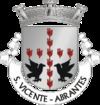Disbanded 2013 Area 38.64 km² Patron Vincent of Saragossa | Subregion Médio Tejo Postal code 2200-301 Population 11,622 (2011) | |
 | ||
São Vicente is a former civil parish, located in the municipality of Abrantes, in Santarém District, Portugal. In 2013, the parish merged into the new parish Abrantes (São Vicente e São João) e Alferrarede. The population in 2011 was 11,622, in an area of 38.20 km². It included the northern part of the city of Abrantes.
Contents
Map of S%C3%A3o Vicente, Portugal
History
A parish of São Vicente is the principal religious organ of the community of Abrantes, and its foundation dates back to the Goths. The ancient church of São Vicente was founded in 1149, after Afonso Henriques took Abrantes Castle, but it subsequently received damage from Moorish attacks and was rebuilt.
It was known until 1150, as the parish of Nossa Senhora da Conceição and reconsecrated by the first alcaide from permission obtained from Afonso Henriques (a reliquiry of São Vicente Mártir was installed in the church). The church was reconstructed under the initiative of King Sebastião, a project that concluded in 1590 under Philip I, completed and elaborated in the mannerist style.
It became a priory and vicarage of the Royal Prior, Father Carvalho e Avelino de Almeida, but by 1758 these institutions (including many of the religious parishes of Abrantes, such as São Pedro and Santa Maria do Castelo) were under the protection of the Marquis of Abrantes. Parish records for 1862 refer to São Vicente being passed on to the Marquis of Abrantes by the Order of Christ. The vicar of São Vicente represented the clergy of São Pedro de Alvega, São Silvestre de Aboboreira, Santa Eufémia de Rio de Moinhos and Santa Luzia do Pego, alternately with the parish of São João Baptista which was the seat of the adjunct, treasury and administration of the diocese.
The parish administration of São Vicente was merged with that of Santa Maria do Castelo around 1834, although records for the latter continued until 1774.
Today, the religious parish is part of the diocese of Portalegre-Castelo Branco.
Geography
The long and narrow parish of São Vicente, which includes the northern half of the city of Abrantes, is mostly a large rural community. Its immediate neighbors are the Abrantes parishes of Carvalhal (to the north), Alferrarede (to the east), São João (to the southeast), São Miguel do Rio Torto (in the southe), Tramagal (in the southwest), Rio de Moinhos and Aldeia do Mato (to the west) and Souto (to the northwest), as well as the municipality of Sardoal (in the northeast). It has as its border the right margin of the Tagus River, which it shares with São Miguel do Rio Torto and Tramagal.
Architecture
Culture
Among its many religious or secular holidays, the parish of São Vicente is remembered for the Festa de São Lourenço (which falls on the last weekend of August and first of September) and the Festa da Abrançalha (which occurs on the last weekend of May or first weekend of June). In addition, the feast days of Paul (July), Our Lady of Graces (May) and Our Lady of Light (8 September) round out the religious celebrations with the community.
